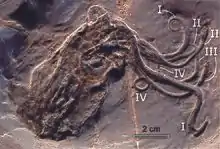Proteroctopus
Proteroctopus is an extinct genus of cephalopod that lived in the Middle Jurassic, approximately 164 million years ago. It is only known from a single species P. ribeti. The single fossil specimen assigned to this species originates from the Lower Callovian of Voulte-sur-Rhône in France. It is currently on display at the Musée de Paléontologie de La Voulte-sur-Rhône.[1] While originally interpreted as an early octopus, a 2016 restudy of the specimen considered it to be a basal member of the Vampyropoda, less closely related to octopus or vampire squid than either of the two groups are to each other.[2] A phylogenetic analysis by Kruta et. al indicates that Proteroctopus may be more closely related to the Vampyromorpha based on its unique morphology: two fins, head fused to the body, eight arms, two rows of oblique sucker, a gladius and absence of an ink sac.[2] A 2022 phylogenetic analysis also found it to be more closely related to vampire squid than to octopuses.[3]
| Proteroctopus Temporal range: Lower | |
|---|---|
 | |
| Proteroctopus ribeti holotype. | |
| Scientific classification | |
| Domain: | Eukaryota |
| Kingdom: | Animalia |
| Phylum: | Mollusca |
| Class: | Cephalopoda |
| Clade: | Vampyropoda |
| Genus: | †Proteroctopus |
| Species: | †P. ribeti |
| Binomial name | |
| †Proteroctopus ribeti Fischer & Riou, 1982 | |
The morphology of P. ribeti suggests a necto-epipelagic mode of life.[1]
References
- Fischer, J.C.; B. Riou (1982). "Le plus ancien octopode connu (Cephalopoda, Dibranchiata): Proteroctopus ribeti nov. gen., nov. sp., du Callovien de l'Ardèche (France)". Comptes Rendus de l'Académie des Sciences, Série II. 295: 277–280.
- Kruta, Isabelle; Rouget, Isabelle; Charbonnier, Sylvain; Bardin, Jérémie; Fernandez, Vincent; Germain, Damien; Brayard, Arnaud; Landman, Neil (November 2016). Korn, Dieter (ed.). "Proteroctopus ribeti in coleoid evolution". Palaeontology. 59 (6): 767–773. Bibcode:2016Palgy..59..767K. doi:10.1111/pala.12265. S2CID 132420410.
- Whalen, Christopher D.; Landman, Neil H. (2022-03-08). "Fossil coleoid cephalopod fr-28333-5/". Nature Communications. 13 (1): 1107. doi:10.1038/s41467-022-28333-5. ISSN 2041-1723. PMC 8904582. PMID 35260548.